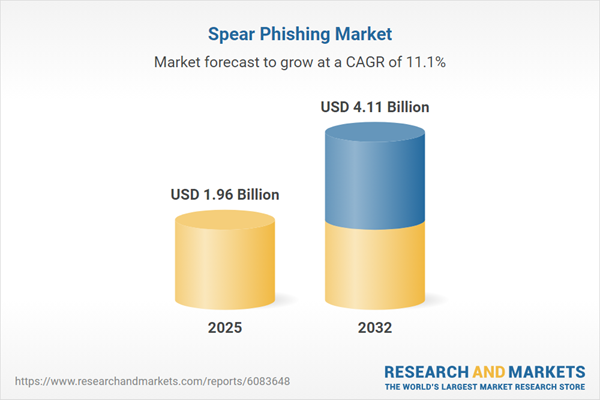Speak directly to the analyst to clarify any post sales queries you may have.
Spear phishing poses a persistent challenge as targeted cyber threats evolve and test the limits of organizational defense. Senior decision-makers must stay abreast of the latest spear phishing techniques and frameworks to strengthen resilience and adapt policy and investment strategies accordingly.
Market Snapshot: Spear Phishing Market Size and Growth
The spear phishing market is experiencing strong growth, expanding from USD 1.76 billion in 2024 to USD 1.96 billion in 2025, and projected to reach USD 4.11 billion by 2032, with a compound annual growth rate of 11.13%. This expansion is driven by rising attack sophistication and the urgent need for advanced cyber defense, especially as organizations worldwide invest in integrated prevention and response capabilities. Forces such as large-scale digital transformation and the ubiquity of digital communication continue to influence sector maturity, as businesses strive to address risks from targeted email threats, social engineering, and related cybersecurity challenges in a complex threat landscape.
Scope & Segmentation of the Spear Phishing Market
The spear phishing market encompasses a comprehensive range of operational, technological, and regulatory considerations that shape executive decisions and cybersecurity posture. Each segment below illustrates unique priorities and evolving risk management strategies:
- Delivery Methods: Email threats—through attachments, links, and plain text—are joined by instant messaging and social media channels, broadening the attack surface that organizations must monitor and protect.
- Deployment Models: Cloud-based protections offer agility and scalability, while on-premises solutions address strict compliance or data sovereignty needs, requiring nuanced security architecture in diverse environments.
- Components: Organizations deploy managed and professional services, alongside detection, prevention, and recovery software, to ensure layered defense and faster response to emerging spear phishing campaigns.
- Organization Size: Large enterprises face unique challenges relating to infrastructure scale, while small and medium businesses adapt cybersecurity tactics according to available resources and exposure.
- Industry Verticals: Key sectors include BFSI, government and defense, healthcare, IT and telecom, manufacturing, and retail, each contending with distinct compliance obligations and evolving threat landscapes.
- Attack Vectors: Common attack types involve credential harvesting via malicious links, spoofed domains, and crafted phishing pages, as well as malware-driven compromises that demand dedicated countermeasures.
- Regional Coverage: Detailed assessments cover North America, Latin America, Europe, Middle East and Africa, and Asia-Pacific, delivering insights that account for regional risks, adoption trends, and regulatory dynamics both at the regional and country level.
Spear Phishing Market: Key Takeaways for Leaders
- Threat actors are increasingly leveraging advanced social engineering and automation, requiring organizations to implement defense strategies that blend endpoint, network, and user-oriented protection.
- The rapid adoption of cloud communication platforms and distributed workforces is introducing new vulnerabilities, emphasizing the need for robust identity and access management reviews.
- Artificial intelligence and machine learning are being used to both enhance cyber attack precision and support real-time detection, necessitating continual upgrades to technical defenses and workforce capabilities.
- Regulatory developments on privacy and incident reporting are accelerating the convergence of technology, process, and compliance, making governance a cross-disciplinary responsibility for executives.
- Participation in sector-wide threat intelligence and information-sharing forums provides valuable insights and supports faster, more coordinated incident responses to new spear phishing tactics.
Impact of United States Tariffs on Global Spear Phishing Security Strategies
Recent adjustments to United States tariffs are influencing global cybersecurity procurement, prompting many organizations to consolidate vendor relationships and invest in integrated platforms. This new landscape has led to longer contract negotiations and increased consideration of local technology providers, compelling leaders to rethink solution architectures and partner evaluation processes to ensure operational resilience.
Methodology & Data Sources
This spear phishing market report utilizes primary research from interviews with cybersecurity practitioners and industry roundtable discussions, complemented by secondary analysis of reputable sector studies and anonymized telemetry from endpoint and email security systems. Extensive cross-validation and expert consultation underpin the objectivity and accuracy of the findings.
Why This Spear Phishing Market Report Matters
- Executives are equipped to align policies, technology, and security training to neutralize current adversary tactics and address regulatory requirements.
- The report provides actionable insights for vendor selection, procurement, and resource allocation, benefitting from detailed segmentation and geographic assessments.
- Leadership can put recommendations into practice to strengthen incident response procedures, elevate security awareness across teams, and enhance executive oversight in risk management and mitigation.
Conclusion
Multi-layered spear phishing defense demands a proactive blend of technology, organizational adaptation, and robust sector collaboration. This report supports leaders in anticipating threat evolution and advancing comprehensive cybersecurity initiatives.
Table of Contents
3. Executive Summary
4. Market Overview
7. Cumulative Impact of Artificial Intelligence 2025
Companies Mentioned
The companies profiled in this Spear Phishing market report include:- Proofpoint, Inc.
- Cisco Systems, Inc.
- Fortinet, Inc.
- Trend Micro Incorporated
- Microsoft Corporation
- Mimecast Limited
- Palo Alto Networks, Inc.
- Broadcom Inc.
- Check Point Software Technologies Ltd.
- FireEye, Inc.
Table Information
| Report Attribute | Details |
|---|---|
| No. of Pages | 189 |
| Published | October 2025 |
| Forecast Period | 2025 - 2032 |
| Estimated Market Value ( USD | $ 1.96 Billion |
| Forecasted Market Value ( USD | $ 4.11 Billion |
| Compound Annual Growth Rate | 11.1% |
| Regions Covered | Global |
| No. of Companies Mentioned | 11 |









